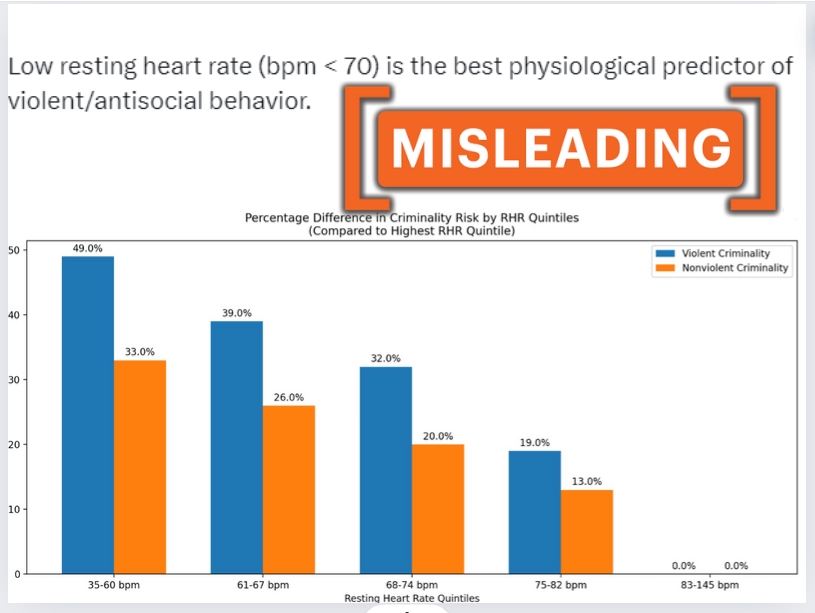By: Emilia Stankeviciute
September 5 2024
 A screenshot of a portion of the post and the graph was shared on X. (Source: X/Modified by Logically Facts)
A screenshot of a portion of the post and the graph was shared on X. (Source: X/Modified by Logically Facts)
Low resting heart rate isn't a reliable predictor of violent behavior. Socioeconomic factors and childhood adversity are stronger predictors.
Context
A viral post on X (archived here) claims that a low resting heart rate (RHR), defined as under 70 beats per minute (bpm), is the strongest physiological predictor of violent and antisocial behavior.
The post, which has garnered 2.1 million views and more than 8,000 likes, references a longitudinal study of more than 700,000 men. According to the post, individuals with the lowest RHR are significantly more likely to engage in both violent and non-violent crimes, have a 31 percent higher risk of car accidents, and face a 41 percent greater chance of being injured in assaults.
The post also asserts that people with low RHR tend to exhibit criminal behavior at a younger age, and the link to antisocial tendencies remains even after accounting for factors like socioeconomic status and physical activity.
In fact
Recent research clarifies the link between low resting heart rate (RHR) and antisocial behavior. While earlier studies suggested a strong connection, a 2023 Mendelian randomization study shows that claims of RHR being the best predictor of violent behavior are misleading. Using genetic data, this approach provides more accurate insights than traditional studies, which external factors can influence.
The 2023 study analyzed data from more than 450,000 people to see if genetic traits linked to low RHR were also connected to antisocial behavior. The results were clear: there is no direct link between low RHR and antisocial behavior, nor any genetic evidence to support this idea. The previously observed association between low RHR and criminality likely stems from external factors such as deprivation or early-life conditions.
These findings challenge earlier research that relied on observational data. For example, a 2015 JAMA Psychiatry study found correlations between low RHR and risky behavior, suggesting that a less active nervous system might trigger sensation-seeking. While informative, such studies did not fully account for the complex interactions between biological, psychological, and environmental influences.
The idea that low RHR is the "best" predictor of antisocial behavior simplifies a much more complicated issue. Many factors contribute to violent behavior, including childhood conduct disorders, impulsivity, and gene-environment interactions involving the MAOA gene, which regulates neurotransmitters. Some MAOA variants are linked to aggression, especially with early-life stress. When combined with adverse circumstances like poverty or abuse, these influences play a much stronger role in shaping antisocial behavior than heart rate alone.
Socioeconomic factors also play a critical role in the link between RHR and behavior. People from disadvantaged backgrounds often face stress, poor nutrition, and other hardships that affect both their development and their chances of engaging in criminal activity. The observed correlation between low RHR and antisocial behavior is likely the result of these broader environmental influences rather than a direct physiological cause.
The verdict
The claim that low RHR is the best predictor of violent and antisocial behavior is misleading. While early studies noted a connection, the 2023 Mendelian randomization study demonstrates that this association is not causal and is likely influenced by other factors, such as socioeconomic deprivation. The role of low RHR in predicting antisocial behavior has been exaggerated, and saying it is the best predictor is inaccurate. Socioeconomic factors, childhood adversity, and psychological traits remain stronger predictors of such behavior.